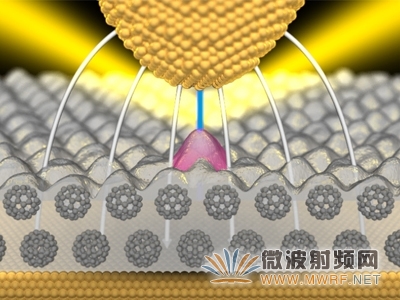德科学家开发出有望成为信息传输新设备的纳米灯
最近,马普学会固态研究所(Max Planck Institute for Polymer Research)的科学家们开发出了一种新光源,通过单分子把电脉冲转换成光脉冲,该分子就像一个光控晶体管的开关,这个开关甚至还能调节光的强度。由于分子打开和关闭的速度极快,这种光源能以千兆赫频率将电信号转换成光信号。虽然这样的分子光源产生的光很微弱,但已经可以用肉眼清晰分辨,因此将有望成为一种新的、有效的信息传输设备。

研究人员将光源发光和晶体管控制亮度这两种功能集成在一个分子上,制成了纳米灯。分子不仅仅能打开和关闭灯,而且能在几毫伏的范围内调节明暗,它在这方面的功能类似于发光晶体管。电场中分子位置的微小变化决定了是否产生光,这使得纳米灯可以通过光传输数字信息,灯亮和灯灭分别意味着字节的1和0。电场对分子的一个微小调节就产生一个字符,这个字符作为光被反射,从而发送一个消息。
在能量转换过程中,电能不是直接,而是通过等离子体振子间接转换为光能的。因为等离子体振子可以在小于100纳米的金属轨道上运行,信息以光的形式可以被传输到更小的空间里。分子的微小尺寸决定了它几乎不需要多少能量,微小的电压变化就已经超出了光源的阈值,所以开关的操作非常快,持续时间不到十亿分之一秒,因此有可能实现以千兆赫频率进行数据传输。
原文阅读:
A nanolamp with lightning-fast switch
A light source and its transistor-operated brightness control shrink to the size of a single molecule
Information is processed and transmitted by ever-smaller components, sometimes with electrons and sometimes with light. Scientists at the Max Planck Institute for Solid State Research in Stuttgart have now developed a light source which converts an electrical voltage pulse into a light pulse by means of a single molecule. Here the molecule functions as a transistor-controlled light switch which even allows the intensity of the light to be regulated. Since the molecular switch allows the light to be switched on and off extremely fast, the light source could serve as a prototype for nano-components that convert electrical into optical signals with gigahertz frequencies.
Today, organic dyes do not just provide colour for carpets, newspapers or clothing when light shines on them. Now they themselves shine in electric light sources, in organic light-emitting diodes (OLEDs), like those in smartphone screens. However, the displays still contain transistors for regulating the brightness alongside the actual light sources (pixels). A team from the Max Planck Institute for Solid State Research, the Max Planck EPFL Center and the Karlsruhe Institute of Technology, has now combined the two functions in a single molecule.
The researchers working with Klaus Kern, Director of the Stuttgart-based Max Planck Institute, construct their nanolamp with integrated transistor control by placing a dye molecule on a layer of Buckminsterfullerenes - which are spherical carbon molecules. The layer of carbon spheres coats a metal carrier, in this case of gold, which serves as an electrode. "As the second electrode above the dye molecule, we use the tip of a scanning tunneling microscope," says Klaus Kuhnke. "But a second metal layer would also be suitable." However, the researchers were only able to discover the astonishing properties of the individual molecule because they used a movable tip for their investigation. What they actually did was to scan the surface with the tip, measuring the light emitted at the same time. "In the process we observed that light is produced on the dye molecules," according to Kuhnke.
The voltage first produces light waves which are trapped on the metal surface
The researchers now regulate the electric field on the molecule with an electrical voltage between the gold carrier and the tip of t
- 安捷伦和阿尔卡特朗讯贝尔实验室联合打破光信号记录(02-03)
